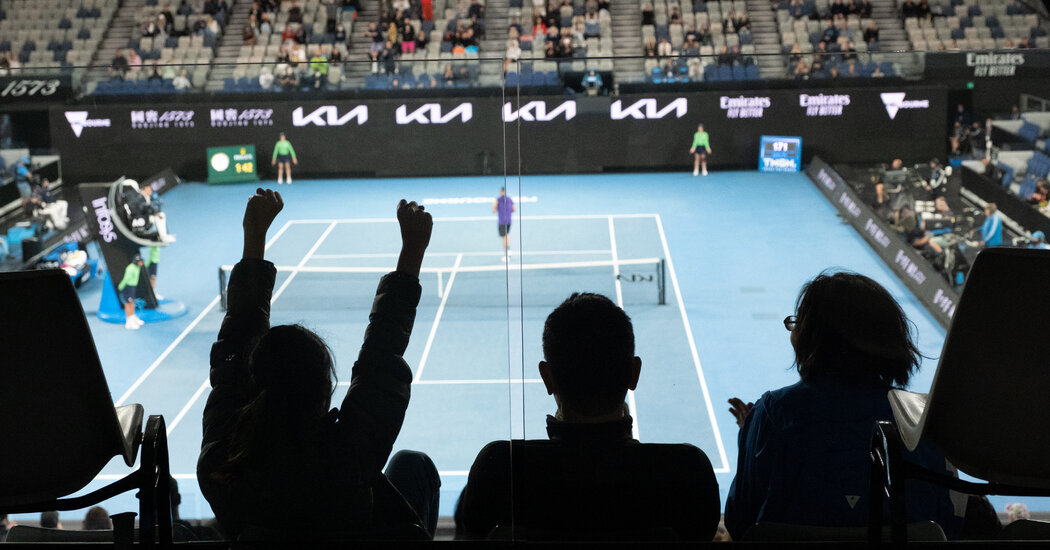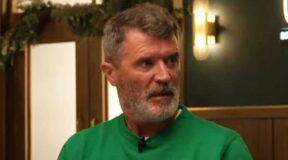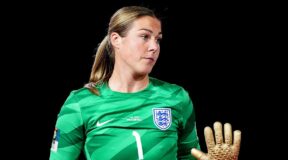MELBOURNE, Australia — “It’s so good to see people.”
This was Naomi Osaka, the three-time Grand Slam champion, moments after her first-round win Monday afternoon at the Australian Open. She stood at a microphone on the court at Rod Laver Arena and peered up at a crowd that seemed, if not normal, then something like it.
That was how it was all across the grounds of Melbourne Park on Monday, where international sports returned, however temporarily, to something like it was before most people knew the difference between a coronavirus and the seasonal flu or used the phrase “social distancing” every third sentence.
Spectators lined up for tickets. They waited in security lines and figured out if they wanted to eat burgers or stuffed pitas or fish and chips, and decided how many $13 beers they could stomach. Despite a light gray sky, a stiff breeze and temperatures in the low 60s, some lounged on the grass or on couches. The fancier people hung out in the restaurant with a champagne sponsor.
It could only safely occur now because the Grand Slam tennis season happens to start in a country that has arguably controlled Covid-19 better than anywhere else, thanks to months of enforced lockdowns, closed borders, thorough testing and contact tracing. Just 909 people in Australia, which has a population of more than 25 million, have died of Covid-19. The country has averaged a half-dozen cases a day during the past two weeks, nearly all of them international arrivals.
Photographers lined the show courts that featured the stars, producing a clatter of clicks at choice moments. A video camera operator wandered the stands, capturing fans that wanted to dance and wave on the stadium screens. Music blasted and a stadium M.C. encouraged them to act goofy during breaks in the action.
And then there were the roars, missing since games sputtered back to life inside largely empty stadiums, especially when a winner or perfectly played volley came off the racket of an Australian player or one of the stars. There were plenty of both on the courts on Monday — both Williams sisters, Osaka, Novak Djokovic and the local favorite Nick Kyrgios.
The smaller the venue, the grander the roar, like on Court 3, a cozy jewel box court where John Millman of Australia played in front of a half-sized crowd of roughly 1,500 fans.
“That’s one of the biggest motivations that we have, the source where we draw our energy and strength and motivation,” Djokovic, the world No. 1, said in anticipation of the noisy welcome he received at Rod Laver, on the court where he has won this championship eight times. “Especially at my age and stage of my career, I’m looking to feed off that energy from the crowd.”
The players had to endure varying degrees of quarantines for two weeks after they arrived, and 72 of them were forced to remain inside their hotel rooms for 14 days after 10 people on three chartered flights tested positive upon arrival. Then they were set free, and after a week of preparation, Monday delivered its payoff.
“Definitely nice to have some people, a lot of people out there,” said Serena Williams, the 23-time Grand Slam champion, after she tore through Laura Siegemund of Germany, 6-1, 6-1.
With spectators capped at 30,000 per day, about half that would show up in normal times, Day 1 at Melbourne Park was a far cry from the summer festival that this tournament is supposed to be. Just 17,922 fans showed up, with plenty of tickets going unsold for any number of reasons — weather, a rejiggered schedule that pushed the tournament back three weeks, Aussie kids no longer on summer break, anger that tennis players, tournament officials and international media members got special exemptions to enter the country and brought in new cases of Covid-19.
The fans who attend will find differences from previous tournaments.
There were Q.R. codes at each gate with spectators expected to register their seats to allow for contact tracing if someone in their section tests positive.
Latest Updates
There were plenty of masks and rules about where and when they must be worn. Local rules require them indoors, but that does not include inside stadiums, unless the retractable roofs are closed. The corridors between outside and the seating bowl count as indoor space, so masks have to be worn there, unless a spectator is eating or drinking in that area.
Workers had painted large circles on the grassy knolls where spectators take in the action on big screens to delineate where each group of fans that arrived together should sit.
Ryan Knight, who lives a 40-minute drive away and comes every year, was trying to get used to all the open space.
The Coronavirus Outbreak ›
Let Us Help You Better Understand the Coronavirus
- Are coronavirus case counts rising in your region? Our maps will help you determine how your state, county or country is fairing.
- Vaccines are rolling out and will reach many of us by spring. We’ve answered some common questions about the vaccines.
- Now that we are all getting used to living in a pandemic, you may have new questions about how to go about your routine safely, how your children will be impacted, how to travel and more. We’re answering those questions as well.
- So far, the coronavirus outbreak has sickened more than 95 million people globally. More than 2 million people have died. A timeline of the events that led to these numbers may help you understand how we got here.
It was just past noon, and Knight was enjoying burgers and fries with his mother, Louise, and his partner, Danielle Locke, in a picnic area where he had his choice of tables.
When organizers confirmed in December that the tournament was on, Knight knew he would not miss the opportunity.
“You can’t live your life in a box,” he said.
How long it will take for everyone who used to attend big events like this one to think and act like the Knights do is anyone’s guess. The players hope it won’t be long.
“A crowd having that sort of noise, somebody get behind them, can really turn things on for somebody,” said Milos Raonic of Canada, who beat Federico Coria of Argentina in straight sets Monday.
Even the usual nuisances were easier to take. In the second set of her match, Venus Williams had to step away from her serve while a mother left the arena to comfort her fussing baby.
Later, Williams was asked whether she appreciated the normalcy of the crowd more after not seeing fans for so long.
“Yeah, I definitely had to live without it before I could appreciate it, which is oftentimes the case in life for us humans,” she said. “I’m appreciative now.”
Karen Crouse contributed reporting.
Source: Read Full Article






